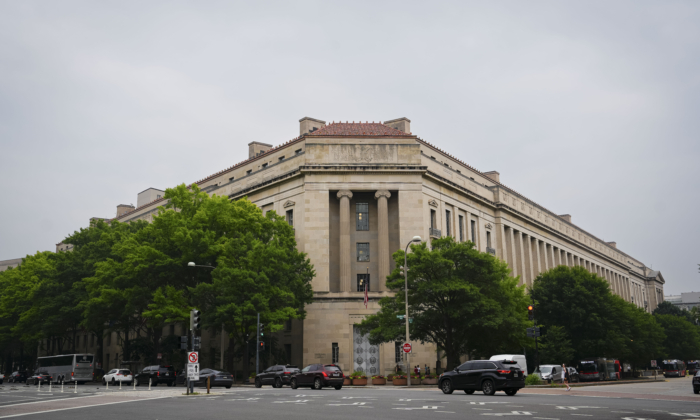



Former President Donald Trump has vowed to finish “draining the swamp”—eliminating special interests and bad actors from the federal government—and make it easier to fire “rogue bureaucrats” who undermine presidential policies.
Other Republican candidates have even bolder plans to attack the so-called administrative state by eliminating entire federal agencies.
Florida Gov. Ron DeSantis would close the IRS and the U.S. Departments of Education, Commerce, and Energy. Former Vice President Mike Pence would shutter the Environmental Protection Agency and the Department of Education, and “clean house” at the Department of Justice (DOJ).
Any of those aims would be abetted by the efforts of a cadre of former Trump staffers who have created a detailed transition plan aimed at dismantling the administrative state beginning on the first day of the next presidential term.
Project 2025 is both a policy agenda and recruitment effort intended to reshape the federal bureaucracy by instituting sweeping policy changes and replacing tens of thousands of federal workers with vetted, trained, ideologically conservative employees ready to execute an extreme makeover of the executive branch.
Project 2025 is detailed in "Mandate for Leadership: The Conservative Promise." The nearly 1,000 page tome was written by a broad coalition of conservative thinkers and activists to seize what they call a “last opportunity to save our republic.”
The group is close to its goal of attracting almost 20,000 potential federal employees who are willing to move to Washington and reshape the government in the mold of modern conservatism, Associate Director Spencer Chretien told The Epoch Times.
“We are doing the next president’s work ahead of time, and expect many of our ideas, people, and plans to become a part of the next conservative administration,” regardless of which conservative candidate is elected, Mr. Chretien said.
“We plan to dismantle the deep state, not the government,” he added said, referring to unelected government employees and business leaders who influence U.S. policy.
That may be easier said than done, according to some constitutional law experts. They point out that the president alone has limited power to institute wholesale change of the kind imagined by Project 2025 and its sponsor organization, The Heritage Foundation.
Others believe the constitutional theory underlying the plan, if allowed to stand by the courts, could further weaken the Republic it aims to save, paving the way for an authoritarian presidency of the kind feared by the Framers of the Constitution.
Growth of the Bureaucracy
Managing the federal government has been a headache for presidents since the time of George Washington. “I anticipate that one of the most difficult and delicate parts of the duty of my office will be that which relates to nominations for appointments,” President Washington wrote shortly after his inauguration in 1789.Then, as now, the Constitution gave precious little guidance about staffing the government below the level of appointed officials, according to Peter Kastor, chair of the history department at Washington University.

“No sooner did the federal government come into being than Americans scrambled to create a federal workforce that could secure the nation’s goals,” Mr. Kastor wrote in an article for Brookings.
Even in infancy, the United States was a vast country facing serious challenges. "All of these challenges required policymaking strategies, but they also required federal personnel to bring those strategies into being,” Mr. Kastor wrote.
By 1802, the country employed jut over 3,900 people. By 1826, the number was more than 10,400.
By 2022, more than 2 million people were employed by the federal government. The vast majority work in the executive branch, staffing more than 400 federal agencies from Agriculture to West Point Academy and from the Bureau of Indian Affairs to the U.S. Mint.
The federal bureaucracy, because of its vast size and scope, is unwieldy and unresponsive even to the president of the United States, according to critics. It has virtually become a fourth branch of the government—the administrative state.
Presidents throughout history have railed against this problem.
President Andrew Jackson swept a number of high ranking public officials from office after his inauguration, including attorneys, bureau chiefs, customs officers, and federal marshals.
“Jackson claimed to be purging the corruption, laxity, and arrogance that came with long tenure, and restoring the opportunity for government service to the citizenry at large through ‘rotation in office,’” Daniel Feller, a history professor at the University of Tennessee, wrote in an article for Brookings.
President Warren Harding appointed friends to high ranking positions, only to find that they were using those offices for personal gain. When critics pointed that out, Harding said, “My ... friends ... they’re the ones that keep me walking the floors nights!”
President Richard Nixon, angered that his cabinet officers were not publicly supporting his policies on Cambodia, and in fact undermining them, retaliated by ordering the White House tennis court removed. President Nixon didn’t enjoy the sport, but some of his cabinet members did.
President Trump saw 92 percent turnover in top-tier staff in the four years of his administration, a record among presidents. Questioned in Sept. 2018 about the so-called turmoil in his administration, President Trump said, "We have acting people. The reason they are acting is because I'm seeing how I like them, and I'm liking a lot of them very, very much. There are people who have done a bad job, and I let them go. If you call that turmoil, I don't call that turmoil. I say that is being smart. That's what we do."

The frustration in executing presidential policy even through hand-picked officials is magnified at the staff level, where tens of thousands of employees are required to implement any policy objective a president might have.
And all of the 2 million federal employees have their own views on policy and are protected from easy dismissal by federal employment laws. They have the power to hinder policy initiatives by slow-walking projects or “quiet quitting,” exerting the bare minimum effort required to stay employed.
"In the federal bureaucracy, it’s complicated because you can't really change policy without having a large number of people who are implementing the changes. And if most of the bureaucrats hate the changes, they will be less enthusiastic,” Richard J. Pierce, a law professor at the George Washington University School of Law, told The Epoch Times.
“There may even be occasional cases where they try and figure out how to undermine the authority of their political boss,” Mr. Pierce said. “So what you get is a source of friction.”
The creators of Project 2025 see more than friction in the operation of federal agencies. They point to an embedded corps of left-leaning staffers bent on thwarting conservative policies.
“Large swaths of the [DOJ] have been captured by an unaccountable bureaucratic managerial class and radical Left ideologues who have embedded themselves throughout its offices and components,” Gene Hamilton wrote in “Mandate for Leadership.”
A key aim of Project 2025 is to eradicate this supposed entrenched class of politicized employees from all federal agencies.
The Vision
Project 2025 proposes a 180-day agenda with agency-specific transition plans to be implemented on the first day of the next administration. The goal is to create “a smaller, politically accountable government that brings the American people what they vote for,” Mr. Chretien said.The Heritage Foundation has seen success with similar, less ambitious, initiatives in the past, according to Mr. Chretien. The group published its first “Mandate for Leadership” in 1981, the year President Ronald Reagan took office.
This ninth edition of the plan was crafted to gain broad acceptance among conservatives by including input from hundreds of political appointees, policy scholars, and leaders in more than 70 conservative groups. The result represents a conservative consensus, according to Mr. Chretien.
“Because Project 2025 includes such a broad array of distinguished individuals and organizations, we will be able to say with confidence to the next conservative president that this is what the whole movement expects,” he said.

Previous versions of "Mandate for Leadership" have gotten results, according to The Heritage Foundation.
President Reagan acted on about half of the ideas from the guide within his first year, according to the Foundation. President Trump’s administration “relied heavily on Heritage’s ‘Mandate' for policy guidance, embracing nearly two-thirds of Heritage’s proposals within just one year in office,” the Project 2025 website states.
Those included additional military spending, ratcheting up work requirements for welfare recipients, and extracting natural resources such as oil, gas, and coal from federal lands, the organization says.
The current version of the plan calls for reinstating “Schedule F,” President Trump’s executive order reclassifying thousands of federal workers as “at-will” employees rather than as civil servants who enjoy legal safeguards.
However, the project’s larger target is to replace the heads of what are usually called independent agencies such as the DOJ, the Centers for Disease Control, Federal Communications Commission (FCC), and Securities and Exchange Commission. These agencies are insulated from political influence to ensure that they act in line with the law and the best interest of the American people.
The project’s organizers see that protection as a license for unelected officials to make their own policy decisions.
“Unaccountable bureaucrats like Anthony Fauci should never again have such broad, unchecked power to issue health ‘guidelines’ that will certainly be the basis for federal and state mandates,” the plan states.
“Never again should public health bureaucrats be allowed to hide information, ignore information, or mislead the public concerning the efficacy or dangers associated with any recommended health interventions because they believe it may lead to hesitancy on the part of the public.”
The plan envisions the U.S. Supreme Court revisiting its 1935 decision in Humphrey’s Executor v. United States, which ensures the independence of certain federal agencies.
The Limits of Executive Power
Key components of Project 2025 rely on the Unitary Executive Theory of constitutional law, which holds that the president has sole authority over the executive branch of government. This relatively new interpretation of presidential power would allow the sweeping changes envisioned by the project’s organizers. The theory has not been fully tested by the courts and it has some pitfalls, according to legal experts.“That's not the way the Constitution is designed to operate,” David M. Driesen, a law professor at Syracuse University College of Law, told The Epoch Times.
"It's a framework document, it doesn't specify everything. But it does envision that there be mostly presidential control but also congressional influence on officials,” Mr. Driesen said.
“The president has big influence on the executive branch. That's by design. But to say he has full control over it, that’s that's just inconsistent with the appointments clause and the impeachment clause because he doesn't completely control who gets fired. The Congress can fire people if they commit high crimes and misdemeanors,” Mr. Driesen said.

Mr. Pierce agrees with the idea that the president should have control over how policies are made and implemented in the federal government and should be able to fire officials who refuse to implement his policies. However, that control should be limited to those in higher federal offices.
“In my version of the unitary executive, the president should have the power to remove any officer of the United States who has the power to make a policy decision on behalf of the United States. And that would certainly include people like commissioners of the Federal Trade Commission and commissioners of the Securities and Exchange Commission,” Mr. Pierce said.
“I expect that the court will be addressing that issue in two to three years,” he added, suggesting a possible re-examination of the Humphrey’s decision.
Yet there are limits to that power, Mr. Pierce maintains. “The president cannot unilaterally terminate an agency. He can't terminate thousands of employees.”
Even so, many presidents have found ways to remove people or reduce the federal workforce without resorting to mass firings.
“Under the Reorganization Act, [the president] has some discretion to relocate agencies. And what President Trump did was relocate a couple of agencies to locations that were considered undesirable,” Mr. Pierce said. “Many of the employees of the agency resigned, quit, or took early retirement rather than making the move from Washington, D.C.”
The vast majority of top-tier officials those who left the Trump administration were not fired but “resigned under pressure,” according to Brookings.
Administrative State or Political State
The greater problem with expanding presidential control over the federal workforce, critics say, is that it would have the opposite effect of that intended. By making loyalty to the president's policy agenda a test for employment for a vast number of federal employees, the plan could ensure political bias in federal agencies rather than eradicate it.Mary Guy, a professor of public administration at the University of Colorado Denver, warned that reinstitution of President Trump’s Schedule F could result in a return to the “spoils system,” in which political supporters are rewarded with jobs.
That won’t be the case, Mr. Chretien maintains. “We are increasing political control of the vast, unaccountable bureaucracy from which it is almost impossible for civil servants to get fired. Any president is entitled to a supportive staff, period,” he said.
Yet Mr. Driesen sees the potential for the development of an administration that is essentially a mechanism for enforcing political loyalty without regard for law.
“It’s not just about how large the state should be. That could be done through legislation. It’s about whether we're going to have a democracy,” Mr. Driesen said.
“Democracies that function have some independent agencies and key posts. They have some traditions to protect civil servants. They have some ways of seeing to it that, at the core, there's a group of people who are more or less dedicated to implementing law and not swaying with political breezes. If that disappears, our democracy is in deep trouble,” Mr. Driesen said, citing Hungary, Poland, and Turkey as examples.
“When you get a unitary executive of the type that conservative jurists imagine is in our Constitution, as soon as you get a bad president, our Democracy is over,” he added.

“The most important single variable is the character of the president,” Mr. Pierce said. “But it's also important to look at the character of the senior appointees,” he added, noting that they become a line of defense against a president who tries to use the apparatus of government to break rather than enforce the law.
That is exactly the situation Project 2025 sponsors say the plan would eliminate, citing the DOJ’s “‘unprecedented politicization and weaponization’ under Biden and Attorney General Merrick Garland, resulting in ‘politically motivated and viewpoint-based prosecutions’ of political enemies and indifference to the crimes of political allies, [which] has made the department ‘a threat to the Republic.’”
“The Mandate for Leadership is public because we want to rally the conservative movement, candidates, and the American people behind this conservative promise,” Mr. Chretien said, noting that the plan itself is "candidate agnostic."
Yet there seems to be nothing to prevent a president of any political ideology from using this enhanced control over the government to remove any bureaucrats whom they deem politically suspect.
The 2025 Question
President Trump is the clear frontrunner in the quest for the 2024 Republican nomination, leading the field by some 39 percentage points in the RealClearPolitics average of major polls.Many Project 2025 supporters, including Mr. Chretien, served in the Trump administration, but organizers haver been in contact with “various presidential candidates” and their staffs, Mr. Chretien said.
Ken Cuccinelli, an ex-Trump staffer who formed the Never Back Down Political Action Committee for Mr. DeSantis, authored a chapter in “Mandate” on revamping the Department of Homeland Security.
Regardless of the candidate, the next president, if a Republican, will likely be very busy on the first day of his or her term.
Mr. DeSantis has promised to take vigorous action to deal with the administrative state on “Day 1” of his administration, if elected, replacing the FBI director, declaring a national emergency to address the border crisis, and removing “woke nonsense” from the military.
Mr. Pence has issued a list of executive actions he would take on the first day of his administration, including freezing discretionary non-defense spending, ending work-from-home for federal employees, and repealing federal support for abortion.
Day one of the next presidential term will be Jan. 20, 2025.


